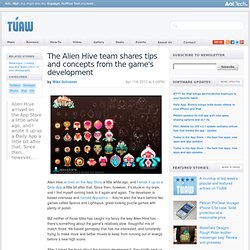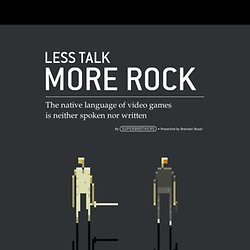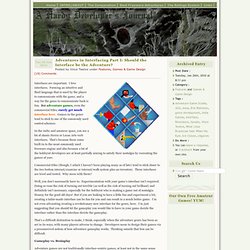

The Alien Hive team shares tips and concepts from the game's development. Alien Hive arrived on the App Store a little while ago, and I wrote it up as a Daily App a little bit after that.

Since then, however, it's stuck in my brain, and I find myself coming back to it again and again. The developer is based overseas and named Appxplore -- they're also the team behind two games called Sporos and Lightopus, great-looking puzzle games with plenty of polish. But neither of those titles has caught my fancy the way Alien Hive has -- there's something about the game's relatively slow, thoughtful mix of match-three, tile-based gameplay that has me interested, and constantly trying to make more and better moves to keep from running out of energy before a new high score.
After I asked the team about the game's development, they kindly sent us some exclusive concept art to share with you. The robot art here is very interesting as well. Finally, Appxplore shared some tips with me about their various strategies behind playing the game. Dead End Thrills. Wot I Think: Superbrothers: Sword & Sworcery EP. By Kieron Gillen on April 20th, 2012 at 5:00 pm.

Let’s be prosaic to begin with. Sword & Sworcery EP is the result of a collaboration between Superbrothers, CAPY and musician Jim Guthrie. It’s converted lovingly from its initial Apple phoney-paddy-thing format last year, where it was very well thought of. It’s a graphic adventure which stresses atmosphere and style over traditional puzzles. I like it. I’m being prosaic, because I’m just about to go off on a 500-word micro-essay tangent. Now, while I’m not entirely convinced by about how its production approach leads to the sort of games it’s trying to hail (which seems to be a bit of a leap of faith), I do appreciate its belief in the power of a unique grammar of gaming.
The Superbrothers manifesto says “Fuck That”. Perhaps that’s first thing to note is that this sense of mood is the main thing it shares with their own rock hall of fame. Other times it leans on a streamlined combat, cut down to an attack and defence button. Less Talk More Rock. By • Presented by Brandon Boyer Not too long ago, Jordan Mechner and Eric Chahi were chatting with Eric Viennot, a French creator and writer.

Jordan Mechner single-handedly pioneered a type of cinematic videogame with Karateka in 1984 and Prince of Persia in 1989. The Key To Lifelike Faces Lies In The Eyes. @tomsamson: True that.

Tron: Legacy's a good example for me—Clu looks pretty good, and from what I could tell his eyes were pretty realistic. But any time he put any emotion into his facial expressions it was like watching a rubber face stretch. The Science Of Size In Video Games. @Zim: Not only that- but I realised while reading the article that when in a game there is an enemy who is smaller, but more powerful than me, it brings about a much stronger sense of panic and irritation in me whenever i'm in a fight with one.

Tickers drive me mad in GoW3, and similarly do Elites in Reach, they're almost the same size as you, but are so, so much more formidable. Really induces a more panicky sensation when I'm fighting them. @Zim: Elites are typically better equipped than brutes as well with active camo and regenerating shields. Elites are also more agile and smaller targets with smaller heads. Brutes don't usually have shields which means they don't usually regenerate health. In certain situations Brutes might be more challenging than elites (like close in fighting) but most of the time elites win out because of versatility not so much pure statistical power. The Art of Computer Game Design. Adventures in Interfacing Part I: Should the Interface be the Ad.
Interfaces are important.

I love interfaces. Forming an intuitive and fluid language that is used by the player to communicate with the game, and a way for the game to communicate back is fun. But adventure games, even the commercial titles, rarely get much interface love. Games in the genre tend to stick to one of the commonly used control schemes. In the indie and amateur space, you see a lot of classic Sierra or Lucas Arts verb interfaces. Commercial titles (though, I admit I haven’t been playing many as of late) tend to stick closer to the two button interact/examine or interact/walk system plus an inventory. Well, you don’t necessarily have to. That’s a difficult distinction to make, I think, especially when the adventure genre has been so set in its ways, with many players adverse to change. Gameplay vs. Adventure games are not traditionally interface-centric games, at least not in the same sense that the more action-oriented games are.
So why mess with the interface? I disagree. Gausswerks: design reboot.